Honeywell MS-9600LSC, MS-9600UDLS, MS-9600LSE, MS-9600UDLSE, MS-9600LS User Manual
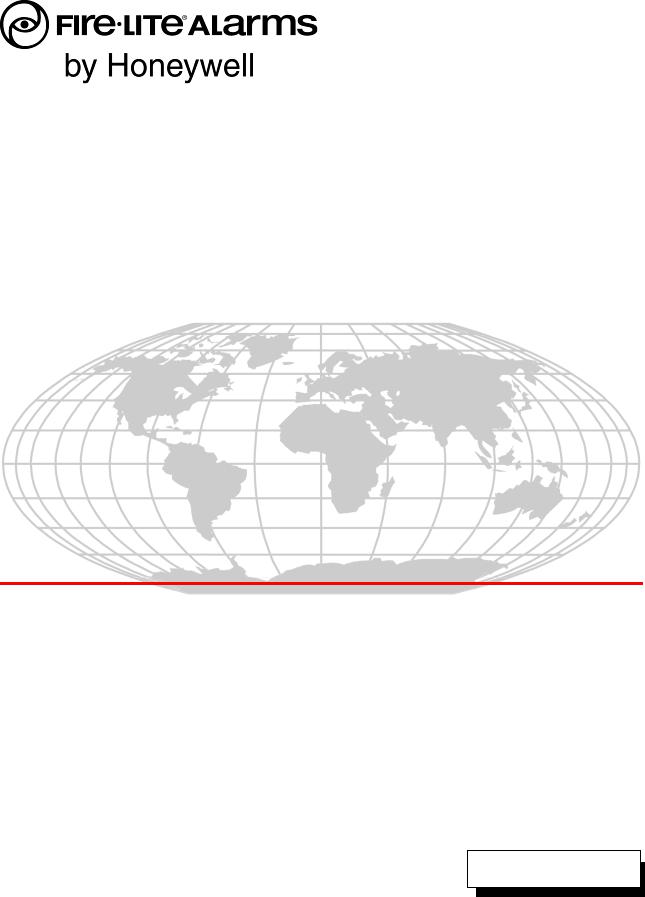
Addressable Fire Alarm Control Panel
MS-9600LS/MS-9600LSE MS-9600UDLS/MS-9600UDLSE
MS-9600LSC
Manual
Document 52646 |
Rev: B2 |
2/12/2010 |
P/N 52646:B2 |
ECN 10-098 |
Fire Alarm System Limitations
While a fire alarm system may lower insurance rates, it is not a substitute for fire insurance!
An automatic fire alarm system—typically made up of smoke detectors, heat detectors, manual pull stations, audible warning devices, and a fire alarm control panel with remote notification capability—can provide early warning of a developing fire. Such a system, however, does not assure protection against property damage or loss of life resulting from a fire.
The Manufacturer recommends that smoke and/or heat detectors be located throughout a protected premise following the recommendations of the National Fire Protection Association Standard 72 (NFPA 72), manufacturer's recommendations, State and local codes, and the recommendations contained in the Guides for Proper Use of System Smoke Detectors, which are made available at no charge to all installing dealers. These documents can be found at http://www.systemsensor.com/html/applicat.html. A study by the Federal Emergency Management Agency (an agency of the United States government) indicated that smoke detectors may not go off in as many as 35% of all fires. While fire alarm systems are designed to provide early warning against fire, they do not guarantee warning or protection against fire. A fire alarm system may not provide timely or adequate warning, or simply may not function, for a variety of reasons:
Smoke detectors may not sense fire where smoke cannot reach the detectors such as in chimneys, in or behind walls, on roofs, or on the other side of closed doors. Smoke detectors also may not sense a fire on another level or floor of a building. A second-floor detector, for example, may not sense a firstfloor or basement fire.
Particles of combustion or “smoke” from a developing fire may not reach the sensing chambers of smoke detectors because:
•Barriers such as closed or partially closed doors, walls, or chimneys may inhibit particle or smoke flow.
•Smoke particles may become “cold,” stratify, and not reach the ceiling or upper walls where detectors are located.
•Smoke particles may be blown away from detectors by air outlets.
•Smoke particles may be drawn into air returns before reaching the detector.
The amount of “smoke” present may be insufficient to alarm smoke detectors. Smoke detectors are designed to alarm at various levels of smoke density. If such density levels are not created by a developing fire at the location of detectors, the detectors will not go into alarm.
Smoke detectors, even when working properly, have sensing limitations. Detectors that have photoelectronic sensing chambers tend to detect smoldering fires better than flaming fires, which have little visible smoke. Detectors that have ion- izing-type sensing chambers tend to detect fast-flaming fires better than smoldering fires. Because fires develop in different ways and are often unpredictable in their growth, neither type of detector is necessarily best and a given type of detector may not provide adequate warning of a fire.
Smoke detectors cannot be expected to provide adequate warning of fires caused by arson, children playing with matches (especially in bedrooms), smoking in bed, and violent explosions (caused by escaping gas, improper storage of flammable materials, etc.).
Heat detectors do not sense particles of combustion and alarm only when heat on their sensors increases at a predetermined rate or reaches a predetermined level. Rate-of-rise heat detectors may be subject to reduced sensitivity over time. For this reason, the rate-of-rise feature of each detector should be tested at least once per year by a qualified fire protection specialist. Heat detectors are designed to protect property, not life.
IMPORTANT! Smoke detectors must be installed in the same room as the control panel and in rooms used by the system for the connection of alarm transmission wiring, communications, signaling, and/or power. If detectors are not so located, a developing fire may damage the alarm system, crippling its ability to report a fire.
Audible warning devices such as bells may not alert people if these devices are located on the other side of closed or partly open doors or are located on another floor of a building. Any warning device may fail to alert people with a disability or those who have recently consumed drugs, alcohol or medication. Please note that:
•Strobes can, under certain circumstances, cause seizures in people with conditions such as epilepsy.
•Studies have shown that certain people, even when they hear a fire alarm signal, do not respond or comprehend the meaning of the signal. It is the property owner's responsibility to conduct fire drills and other training exercise to make people aware of fire alarm signals and instruct them on the proper reaction to alarm signals.
•In rare instances, the sounding of a warning device can cause temporary or permanent hearing loss.
A fire alarm system will not operate without any electrical power. If AC power fails, the system will operate from standby batteries only for a specified time and only if the batteries have been properly maintained and replaced regularly.
Equipment used in the system may not be technically compatible with the control panel. It is essential to use only equipment listed for service with your control panel.
Telephone lines needed to transmit alarm signals from a premise to a central monitoring station may be out of service or temporarily disabled. For added protection against telephone line failure, backup radio transmission systems are recommended.
The most common cause of fire alarm malfunction is inadequate maintenance. To keep the entire fire alarm system in excellent working order, ongoing maintenance is required per the manufacturer's recommendations, and UL and NFPA standards. At a minimum, the requirements of NFPA 72 shall be followed. Environments with large amounts of dust, dirt or high air velocity require more frequent maintenance. A maintenance agreement should be arranged through the local manufacturer's representative. Maintenance should be scheduled monthly or as required by National and/or local fire codes and should be performed by authorized professional fire alarm installers only. Adequate written records of all inspections should be kept.
Limit-C1-2-2007
2 |
MS-9600LS Series Manual — P/N 52646:B2 2/12/2010 |

Installation Precautions
Adherence to the following will aid in problem-free installation with long-term reliability:
WARNING - Several different sources of power can be connected to the fire alarm control panel. Disconnect all sources of power before servicing. Control unit and associated equipment may be damaged by removing and/or inserting cards, modules, or interconnecting cables while the unit is energized. Do not attempt to install, service, or operate this unit until manuals are read and understood.
CAUTION - System Re-acceptance Test after Software Changes: To ensure proper system operation, this product must be tested in accordance with NFPA 72 after any programming operation or change in site-specific software. Reacceptance testing is required after any change, addition or deletion of system components, or after any modification, repair or adjustment to system hardware or wiring. All components, circuits, system operations, or software functions known to be affected by a change must be 100% tested. In addition, to ensure that other operations are not inadvertently affected, at least 10% of initiating devices that are not directly affected by the change, up to a maximum of 50 devices, must also be tested and proper system operation verified.
This system meets NFPA requirements for operation at 0-49º C/32-120º F and at a relative humidity 93% ± 2% RH (noncondensing) at 32°C ± 2°C (90°F ± 3°F). However, the useful life of the system's standby batteries and the electronic components may be adversely affected by extreme temperature ranges and humidity. Therefore, it is recommended that this system and its peripherals be installed in an environment with a normal room temperature of 15-27º C/60-80º F.
Verify that wire sizes are adequate for all initiating and indicating device loops. Most devices cannot tolerate more than a 10% I.R. drop from the specified device voltage.
Like all solid state electronic devices, this system may operate erratically or can be damaged when subjected to lightning induced transients. Although no system is completely immune from lightning transients and interference, proper grounding will reduce susceptibility. Overhead or outside aerial wiring is not recommended, due to an increased susceptibility to nearby lightning strikes. Consult with the Technical Services Department if any problems are anticipated or encountered.
Disconnect AC power and batteries prior to removing or inserting circuit boards. Failure to do so can damage circuits.
Remove all electronic assemblies prior to any drilling, filing, reaming, or punching of the enclosure. When possible, make all cable entries from the sides or rear. Before making modifications, verify that they will not interfere with battery, transformer, or printed circuit board location.
Do not tighten screw terminals more than 9 in-lbs. Overtightening may damage threads, resulting in reduced terminal contact pressure and difficulty with screw terminal removal.
This system contains static-sensitive components.
Always ground yourself with a proper wrist strap before handling any circuits so that static charges are removed from the body. Use static suppressive packaging to protect electronic assemblies removed from the unit.
Follow the instructions in the installation, operating, and programming manuals. These instructions must be followed to avoid damage to the control panel and associated equipment. FACP operation and reliability depend upon proper installation.
Precau-D1-9-2005
FCC Warning
WARNING: This equipment generates, uses, and can |
Canadian Requirements |
|
radiate radio frequency energy and if not installed and |
This digital apparatus does not exceed the Class A limits |
|
used in accordance with the instruction manual may |
||
for radiation noise emissions from digital apparatus set |
||
cause interference to radio communications. It has been |
||
out in the Radio Interference Regulations of the Cana- |
||
tested and found to comply with the limits for class A |
||
dian Department of Communications. |
||
computing devices pursuant to Subpart B of Part 15 of |
||
Le present appareil numerique n'emet pas de bruits |
||
FCC Rules, which is designed to provide reasonable |
||
protection against such interference when devices are |
radioelectriques depassant les limites applicables aux |
|
operated in a commercial environment. Operation of this |
appareils numeriques de la classe A prescrites dans le |
|
equipment in a residential area is likely to cause interfer- |
Reglement sur le brouillage radioelectrique edicte par le |
|
ence, in which case the user will be required to correct |
ministere des Communications du Canada. |
|
the interference at his or her own expense. |
|
LiteSpeed™ is a trademark; and FireLite® Alarms is a registered trademark of Honeywell International Inc. Microsoft® and Windows® are registered trademarks of the Microsoft Corporation.
©Tuesday, August 14, 2012 9:31 am by Honeywell International Inc. All rights reserved. Unauthorized use of this document is strictly prohibited.
MS-9600LS Series Manual — P/N 52646:B2 2/12/2010 |
3 |
Software Downloads
In order to supply the latest features and functionality in fire alarm and life safety technology to our customers, we make frequent upgrades to the embedded software in our products. To ensure that you are installing and programming the latest features, we strongly recommend that you download the most current version of software for each product prior to commissioning any system. Contact Technical Support with any questions about software and the appropriate version for a specific application.
Documentation Feedback
Your feedback helps us keep our documentation up-to-date and accurate. If you have any comments or suggestions about our online Help or printed manuals, you can email us.
Please include the following information:
•Product name and version number (if applicable) •Printed manual or online Help
•Topic Title (for online Help) •Page number (for printed manual)
•Brief description of content you think should be improved or corrected •Your suggestion for how to correct/improve documentation
Send email messages to:
FireSystems.TechPubs@honeywell.com
Please note this email address is for documentation feedback only. If you have any technical issues, please contact Technical Services.
4 |
MS-9600LS Series Manual — P/N 52646:B2 2/12/2010 |
Table of Contents |
|
Section 1: Product Description ............................................................................................. |
13 |
1.1: Inventory...................................................................................................................................................... |
13 |
1.2: Features and Options ................................................................................................................................... |
13 |
1.3: Specifications............................................................................................................................................... |
15 |
1.3.1: Current Availability........................................................................................................................... |
17 |
1.4: Controls and Indicators................................................................................................................................ |
17 |
1.5: Circuits......................................................................................................................................................... |
18 |
1.6: Components ................................................................................................................................................. |
19 |
1.6.1: Intelligent Addressable Detectors: Newer Series .............................................................................. |
20 |
1.6.2: Intelligent Addressable Modules: Newer Series ............................................................................... |
20 |
1.6.3: 300 Series Intelligent Addressable Devices ...................................................................................... |
20 |
1.6.4: Addressable Device Accessories ....................................................................................................... |
20 |
1.7: Optional Modules ........................................................................................................................................ |
21 |
1.8: Accessories .................................................................................................................................................. |
21 |
1.8.1: PS-Tools Programming Utility.......................................................................................................... |
21 |
1.8.2: Dress Panel: DP-9692........................................................................................................................ |
22 |
1.8.3: TR-CE Trim Ring.............................................................................................................................. |
22 |
1.8.4: Battery Box........................................................................................................................................ |
22 |
1.8.5: Battery Charger.................................................................................................................................. |
22 |
CHG-75 Battery Charger...................................................................................................................... |
22 |
CHG-120 Battery Charger.................................................................................................................... |
22 |
1.8.6: New ANN-BUS Annunciators/Devices ............................................................................................ |
23 |
ANN-BUS Wiring ................................................................................................................................ |
23 |
ANN-BUS Device Addressing............................................................................................................. |
26 |
ANN-80 Remote Fire Annunciator ...................................................................................................... |
27 |
ANN-S/PG Serial/Parallel Interface Installation.................................................................................. |
30 |
ANN-I/O LED Driver Module* ........................................................................................................... |
32 |
ANN-LED Annunciator Module*........................................................................................................ |
34 |
ANN-RLY Annunciator Module.......................................................................................................... |
36 |
ANN-BUS Audio Panel Control .......................................................................................................... |
38 |
1.8.7: Legacy ACS Annunciators ................................................................................................................ |
40 |
1.9: Getting Started ............................................................................................................................................. |
40 |
Section 2: Installation............................................................................................................. |
42 |
2.1: Mounting...................................................................................................................................................... |
42 |
2.2: Power ........................................................................................................................................................... |
46 |
2.2.1: AC Power and Earth Ground Connection ......................................................................................... |
46 |
2.2.2: Battery Power .................................................................................................................................... |
46 |
2.2.3: Special Application DC Power Output Connection .......................................................................... |
47 |
2.3: Relays .......................................................................................................................................................... |
47 |
2.4: Notification Appliance Circuits................................................................................................................... |
47 |
2.4.1: Configuring NACs............................................................................................................................. |
48 |
2.4.2: Style Y (Class B) NAC Wiring ......................................................................................................... |
49 |
2.4.3: Style Z (Class A) NAC Wiring.......................................................................................................... |
49 |
2.5: Power-limited Wiring Requirements ........................................................................................................... |
50 |
2.6: Optional Modules and Devices.................................................................................................................... |
51 |
2.6.1: DACT-UD2 Installation ................................................................................................................... |
52 |
2.6.2: 4XTMF Transmitter Module Installation.......................................................................................... |
55 |
2.6.3: Auxiliary Trouble Input (J16 & J17)................................................................................................. |
57 |
2.6.4: SLC-2LS Expander Module .............................................................................................................. |
57 |
2.6.5: Printer/PC .......................................................................................................................................... |
58 |
2.6.6: Annunciators...................................................................................................................................... |
59 |
Legacy ACM-8RF Relay Control Module........................................................................................... |
59 |
Legacy ACM Series Annunciators....................................................................................................... |
60 |
MS-9600LS Series Manual — P/N 52646:B2 2/12/2010 |
5 |

Table of Contents |
|
Section 3: Programming ........................................................................................................ |
61 |
3.1: Programming Data Entry ............................................................................................................................. |
61 |
3.2: User Programming ....................................................................................................................................... |
62 |
3.3: Initial Power-up............................................................................................................................................ |
63 |
3.4: Programming Screens Description .............................................................................................................. |
63 |
3.5: Programming and Passwords....................................................................................................................... |
63 |
3.6: Master Programming Level ......................................................................................................................... |
65 |
3.6.1: Autoprogram...................................................................................................................................... |
66 |
3.6.2: Point Program .................................................................................................................................... |
67 |
Detector Programming.......................................................................................................................... |
67 |
Module Programming........................................................................................................................... |
78 |
3.6.3: Zone Setup ......................................................................................................................................... |
95 |
Enable ................................................................................................................................................... |
95 |
Disable .................................................................................................................................................. |
96 |
Zone 97, 98 and 99 ............................................................................................................................... |
96 |
Zones Installed...................................................................................................................................... |
97 |
Zones Enabled ...................................................................................................................................... |
97 |
Zones Disabled ..................................................................................................................................... |
97 |
Zone Type............................................................................................................................................. |
98 |
Zones Available.................................................................................................................................... |
99 |
3.6.4: Loop Setup......................................................................................................................................... |
99 |
Loop Selection...................................................................................................................................... |
99 |
Loop Protocol ..................................................................................................................................... |
100 |
3.6.5: System Setup ................................................................................................................................... |
100 |
Trouble Reminder............................................................................................................................... |
101 |
Banner................................................................................................................................................. |
101 |
Time-Date........................................................................................................................................... |
103 |
Timers................................................................................................................................................. |
105 |
NAC (Notification Appliance Circuit) ............................................................................................... |
107 |
Relays ................................................................................................................................................. |
112 |
Canadian Option ................................................................................................................................. |
113 |
Waterflow Silenceable........................................................................................................................ |
114 |
3.6.6: Verify Loops.................................................................................................................................... |
114 |
3.6.7: History ............................................................................................................................................. |
115 |
View Events........................................................................................................................................ |
115 |
Erase History ...................................................................................................................................... |
115 |
3.6.8: Walktest ........................................................................................................................................... |
116 |
3.6.9: Option Modules .............................................................................................................................. |
117 |
Annunciators/UDACT........................................................................................................................ |
118 |
On Board DACT................................................................................................................................. |
134 |
Printer/PC ........................................................................................................................................... |
134 |
3.6.10: Password Change........................................................................................................................... |
135 |
3.6.11: Clear Program................................................................................................................................ |
136 |
3.6.12: Program Check .............................................................................................................................. |
137 |
3.7: Maintenance Programming Level.............................................................................................................. |
138 |
3.7.1: Disable Point.................................................................................................................................... |
139 |
3.7.2: History ............................................................................................................................................. |
140 |
3.7.3: Program Check ................................................................................................................................ |
141 |
3.7.4: Walktest ........................................................................................................................................... |
142 |
3.7.5: System.............................................................................................................................................. |
143 |
3.7.6: Zone Setup ....................................................................................................................................... |
144 |
Zones Installed.................................................................................................................................... |
146 |
Zones Enabled .................................................................................................................................... |
146 |
Zones Disabled ................................................................................................................................... |
147 |
Zone Type........................................................................................................................................... |
147 |
Zones Available.................................................................................................................................. |
148 |
Zone Message ..................................................................................................................................... |
149 |
6 |
MS-9600LS Series Manual — P/N 52646:B2 2/12/2010 |

|
Table of Contents |
Section 4: Operating Instructions ....................................................................................... |
150 |
4.1: Panel Control Buttons................................................................................................................................ |
150 |
4.1.1: Acknowledge/Step........................................................................................................................... |
150 |
4.1.2: Alarm Silence .................................................................................................................................. |
150 |
4.1.3: Drill/Hold 2 Sec............................................................................................................................... |
150 |
4.1.4: Reset ................................................................................................................................................ |
150 |
4.2: LED Indicators........................................................................................................................................... |
150 |
4.3: Normal Operation ...................................................................................................................................... |
151 |
4.4: Trouble Operation...................................................................................................................................... |
152 |
4.5: Alarm Operation ........................................................................................................................................ |
153 |
4.6: Supervisory Operation ............................................................................................................................... |
154 |
4.7: Process Monitor Operation ........................................................................................................................ |
155 |
4.8: Hazard Condition Operation...................................................................................................................... |
155 |
4.9: Medical Alert Condition Operation ........................................................................................................... |
156 |
4.10: Programmed Zone Operation .................................................................................................................. |
156 |
4.11: Disable/Enable Operation ........................................................................................................................ |
156 |
4.12: Waterflow Circuits Operation.................................................................................................................. |
156 |
4.13: Detector Functions................................................................................................................................... |
156 |
4.14: Time Functions: Real-Time Clock........................................................................................................... |
157 |
4.15: NAC Operation........................................................................................................................................ |
157 |
4.16: Synchronized NAC Operation................................................................................................................. |
157 |
4.17: Coded Operation...................................................................................................................................... |
157 |
4.18: Presignal .................................................................................................................................................. |
158 |
4.19: Positive Alarm Sequence......................................................................................................................... |
158 |
4.20: Special System Timers............................................................................................................................. |
159 |
4.20.1: Silence Inhibit Timer..................................................................................................................... |
159 |
4.20.2: Autosilence Timer ......................................................................................................................... |
159 |
4.20.3: Trouble Reminder.......................................................................................................................... |
159 |
4.20.4: Waterflow Retard Timer................................................................................................................ |
159 |
4.20.5: Alarm Verification......................................................................................................................... |
159 |
4.21: Walktest ................................................................................................................................................... |
160 |
4.22: Read Status .............................................................................................................................................. |
160 |
4.22.1: System Point.................................................................................................................................. |
162 |
4.22.2: Zones ............................................................................................................................................. |
163 |
4.22.3: Power............................................................................................................................................. |
164 |
4.22.4: Trouble Reminder.......................................................................................................................... |
165 |
4.22.5: Timers............................................................................................................................................ |
165 |
4.22.6: NAC............................................................................................................................................... |
166 |
4.22.7: Relays ............................................................................................................................................ |
166 |
4.22.8: Program Check .............................................................................................................................. |
167 |
4.22.9: History ........................................................................................................................................... |
167 |
4.22.10: Annunciators................................................................................................................................ |
167 |
4.22.11: Phone Line................................................................................................................................... |
169 |
4.22.12: Central Station ............................................................................................................................. |
169 |
4.22.13: Service Terminal.......................................................................................................................... |
170 |
4.22.14: Printer/PC .................................................................................................................................... |
170 |
4.22.15: Print ............................................................................................................................................. |
171 |
4.22.16: Time-Date.................................................................................................................................... |
173 |
Section 5: Power Supply Calculations................................................................................ |
174 |
5.1: Overview.................................................................................................................................................... |
174 |
5.2: Calculating the AC Branch Circuit............................................................................................................ |
174 |
5.3: Calculating the System Current Draw ....................................................................................................... |
174 |
5.3.1: Overview ......................................................................................................................................... |
174 |
5.3.2: How to Use Table 5.3 on page 176 to Calculate System Current Draw ......................................... |
175 |
5.4: Calculating the Battery Size ...................................................................................................................... |
177 |
5.4.1: NFPA Battery Requirements........................................................................................................... |
177 |
MS-9600LS Series Manual — P/N 52646:B2 2/12/2010 |
7 |

Table of Contents |
|
5.4.2: Selecting and Locating Batteries ..................................................................................................... |
177 |
Appendix A: Software Zones............................................................................................... |
178 |
A.1: Correlations............................................................................................................................................... |
178 |
Appendix B: Default Programming ..................................................................................... |
186 |
Appendix C: NFPA Standard-Specific Requirements ....................................................... |
187 |
C.1: Central Station/Remote Station Transmitter: Connection to FACP Dry Contacts.................................... |
193 |
C.2: MBT-1 Municipal Box Trip - Silenceable................................................................................................. |
194 |
Appendix D: FACP with Keltron .......................................................................................... |
195 |
Appendix E: Wire Requirements ......................................................................................... |
196 |
E.1: NAC Wiring............................................................................................................................................... |
197 |
Appendix F: HVAC Control .................................................................................................. |
198 |
F.1: Control Module Operation ......................................................................................................................... |
198 |
F.1.1: HVAC SHUTDN............................................................................................................................. |
198 |
F.2: Monitor Module Operation ........................................................................................................................ |
198 |
F.2.1: HVAC RESTART ........................................................................................................................... |
198 |
F.2.2: HVAC OVRRIDE ........................................................................................................................... |
199 |
Appendix G: Canadian Application..................................................................................... |
200 |
Index ...................................................................................................................................... |
201 |
8 |
MS-9600LS Series Manual — P/N 52646:B2 2/12/2010 |
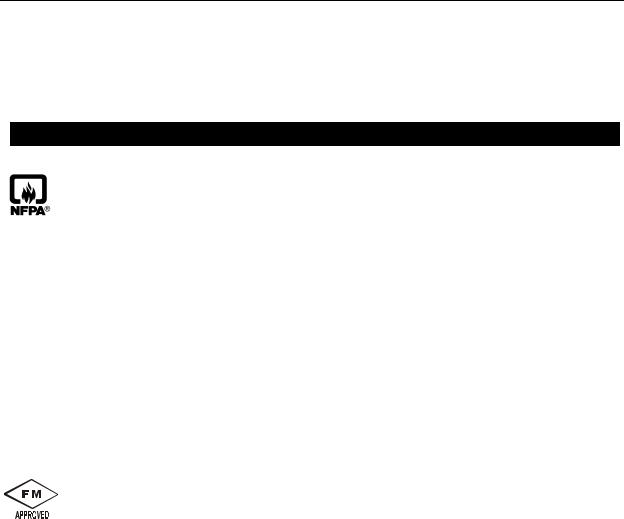
It is imperative that the installer understand the requirements of the Authority Having Jurisdiction (AHJ) and be familiar with the standards set forth by the following regulatory agencies:
•Underwriters Laboratories Standards
•NFPA 72 National Fire Alarm Code
•CAN/ULC - S527-99 Standard for Control Units for Fire Alarm Systems
Before proceeding, the installer should be familiar with the following documents.
NFPA Standards
NFPA 72 National Fire Alarm Code
NFPA 70 National Electrical Code
Underwriters Laboratories Documents:
UL 38 Manually Actuated Signaling Boxes
UL 217 Smoke Detectors, Single and Multiple Station
UL 228 Door Closers–Holders for Fire Protective Signaling Systems
UL 268 Smoke Detectors for Fire Protective Signaling Systems
UL 268A Smoke Detectors for Duct Applications
UL 346 Waterflow Indicators for Fire Protective Signaling Systems
UL 464 Audible Signaling Appliances
UL 521 Heat Detectors for Fire Protective Signaling Systems
ANSI/UL 864, Control Units and Accessories for Fire Alarm Systems
UL 1481 Power Supplies for Fire Protective Signaling Systems
UL 1610 Central Station Burglar Alarm Units
UL 1638 Visual Signaling Appliances
UL 1971 Signaling Devices for Hearing Impaired
UL 2017 General-Purpose Signaling Devices and System
CAN/ULC - S524-01 Standard for Installation of Fire Alarm Systems
CAN/ULC - S527-99 Standard for Control Units for Fire Alarm Systems
CAN\ULC - S559-04 Equipment for Fire Signal Receiving Centers and Systems
CAN\ULC - S561-03 Installation and Services for Fire Signal Receiving Centers and Systems
Note: MS-9600LSE/MS-9600UDLSE is not ULC listed for Canadian applications
This Class (A) digital apparatus complies with Canadian ICES-003.
Cet appareil numérique de la classe (A) est conforme à la norme NMB-003 du Canada.
FM Approved to ANSI/UL 864
Other:
EIA-232E Serial Interface Standard
EIA-485 Serial Interface Standard
NEC Article 250 Grounding
NEC Article 300 Wiring Methods
NEC Article 760 Fire Protective Signaling Systems
Applicable Local and State Building Codes
Requirements of the Local Authority Having Jurisdiction (LAHJ)
Fire-Lite Documents:
Fire-Lite Device Compatibility |
Document #15384 |
SLC Wiring Manual |
Document #51309 |
ACS Series Annunciators |
Document #51480 |
411UD Communicator/Transmitter |
Document #50759 |
411UDAC Communicator/Transmitter |
Document #51073 |
CHG-120F Battery Charger |
Document #50888 |
CHG-75 Battery Charger |
Document #51315 |
LDM Series Lamp Driver Modules |
Document #50055 |
LCD-80F Remote Fire Annunciator |
Document #51338 |
ACM-8RF Relay Control Module |
Document #50362 |
DACT-UD2 Manual |
Document #53037 |
IDACT Communicator/Transmitter |
Document #53109 |
ANN-80 Installation Document |
Document #52749 |
ANN-(R)LED Installation Document |
Document #53032 |
ANN-I/O Installation Document |
Document #151416 |
ANN-RLY Installation Document |
Document #53033 |
ANN-S/PG Installation Document |
Document #151417 |
ACC-25/50(ZS/T) Manual |
Document #51889 |
This product has been certified to comply with the requirements in the ANSI/UL 864, Standard for Control Units and Accessories for Fire Alarm Systems, 9th Edition. Operation of this product with products not tested for ANSI/UL 864, 9th Edition has not been evaluated. Such operation requires the approval of the local Authority Having Jurisdiction (AHJ).
MS-9600LS Series Manual — P/N 52646:B2 2/12/2010 |
9 |
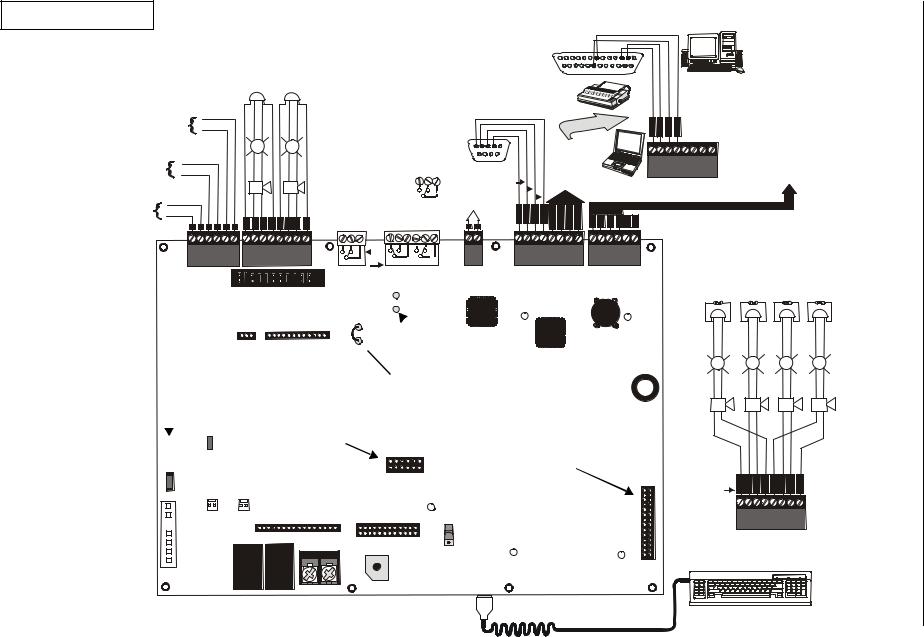
10
2/12/2010 52646:B2 P/N — Manual Series 9600LS-MS
Notification Appliance Circuits
Basic System Connections |
|
Special Application Power |
|
|
|
|
Power-limited, supervised circuits |
|
|
||||
|
|
NAC #1 & #2 Sytle Z (Class A) |
EIA-232 to printer or |
|
||
|
|
3.0 amps max per circuit |
|
|
||
Special Application Power |
|
JP8 configured for Class A |
|
personal computer |
|
|
|
using NACKEY card |
2 Programmable Relays & |
Power-limited |
|
||
DC Power Outputs (24 VDC) |
|
(See Style Y illustrated |
for EDP-listed equipment |
13 12 11 10 9 8 7 6 5 4 3 2 1 |
||
Power-limited, nonsupervised circuits |
|
near right edge of board) |
1 Fixed Trouble Relay |
or personal computer with |
25 24 23 22 21 20 19 18 17 16 15 14 |
|
Supervise with a power supervision |
|
NAC #1 |
NAC #2 |
(nonsupervised) |
FACP Upload/Downlad |
|
relay EOLR-1 |
|
+ |
+ |
Contact Ratings: |
Utility. 50 foot maximum |
|
|
|
2.0 amps @ 30VDC (resistive) |
within same room. |
|
||
Nonresettable Power #2 - 24 VDC |
|
|
|
|
||
|
|
|
0.5 amp @ 30 VAC (resistive) |
|
|
|
filtered, power-limited, (1.5 amps |
|
6 |
|
Contacts show in normal condi- |
|
|
maximum) Supervision required. |
|
5 |
|
tion (AC power with no alarm, |
OR |
|
Suitable for powering annunciators. |
|
|
trouble, or supervisory activity). |
|||
Nonresettable Power #1 - 24 VDC |
|
|
|
|
|
|
|
+ |
|
|
+ |
|
|
A fail-safe trouble relay switches |
|
5 |
4 |
3 |
2 |
1 |
|
|
|
|
|
|
||||
|
|
|
|
|
|
|
|
|
|
|
|
|
|
|
|
|
|
|
|
|
|
|
|
|
||||||
filtered, power-limited, (1.5 amps |
|
4 |
|
|
|
|
|
|
|
|
|
|
|
|
|
9 |
8 |
7 |
6 |
|
TERM |
|
|
|
|
|||||
|
|
|
|
|
|
|
|
|
|
|
|
to the NO position during |
NC NO C |
|
|
DB9F |
|
|
|
|
|
|||||||||
maximum) Supervision required. |
|
3 |
|
|
|
|
|
|
|
|
|
|
|
trouble conditions and |
|
|
|
|
|
Red |
|
(EIA-485) |
|
|
|
|||||
Suitable for powering annunciators. |
|
|
|
|
|
|
+ |
|
|
+ |
|
|
|
ACN/ANN-BUS White |
|
|
|
|
||||||||||||
|
|
|
|
|
|
|
|
|
|
|
|
|
under loss all power. |
|
|
(EIA-485) |
|
|
|
to LCD-80F |
|
|
||||||||
Resettable Power - 24 VDC |
filtered, |
|
|
|
|
|
|
|
|
|
|
|
|
|
|
|
|
|
to annunciators Green |
|
|
|
|
|
|
|||||
2 |
|
|
|
|
|
|
|
|
|
|
|
|
|
|
|
|
(power-limited, |
Black |
|
|
|
|
|
|
||||||
power-limited, (1.5 amps maximum) |
|
|
|
|
|
|
|
|
|
|
|
|
Alarm* |
Trouble Supervisory* |
supervised) |
T R D G |
I I O O |
|
|
|
||||||||||
|
|
|
|
|
|
|
|
|
|
|
|
|
|
|
|
|||||||||||||||
to smoke detectors. |
|
1 |
|
|
|
|
|
B A A B B A A |
B |
|
|
|
|
X C T |
N |
N N U U |
B |
A B A A B |
||||||||||||
|
|
- + |
- |
|
- |
NO NC C |
NO NC C |
NO NC C |
|
+ - |
|
|
V R D |
+ - T |
T |
|||||||||||||||
Supervision required. |
|
|
+ |
+ |
+ |
+ - |
- |
+ |
+ |
- |
- |
NO NC C |
NC NO C |
NO NC C |
|
|
|
|
|
+ |
- |
+ |
+ - |
- |
||||||
|
|
|
|
|
|
|
|
|
|
|
|
|
|
|
|
|
|
|
|
|
|
|
|
|
|
|
|
|
|
shield |
|
|
|
TB3 |
|
|
|
|
|
|
|
|
|
|
|
|
|
TB1 |
|
|
|
|
|
|
|
|
|
|
|
|
|
|
|
|
|
|
|
|
|
|
|
|
|
|
|
TB4 |
|
TB5 |
|
|
TB6 |
|
|
|
TB7 |
|
|
|
|
|
|
|
|
|
|
|
|
|
|
|
|
|
|
|
|
|
|
|
|
|
|
|
|
|
|
|
|
|
|
||||
|
|
|
|
|
|
|
|
|
|
|
|
|
|
|
|
|
|
|
|
|
|
|
|
|
|
|
|
|||
|
|
|
|
|
|
|
|
|
|
|
|
|
|
|
JP8 |
(*Factory default relay programming |
|
|
|
|
|
|
|
|
|
|
||||
|
|
|
|
|
|
|
|
|
|
|
|
|
|
|
as shown on circuit board) |
|
|
|
|
|
|
|
|
|
|
|
|
|||
|
|
|
|
|
|
|
|
|
|
|
|
|
|
|
|
|
|
|
|
|
|
|
|
|
|
|
|
|||
T R D G |
SLC Loop |
X C T N |
(Supervised Power-limited) |
V R D |
|
|
Refer to the SLC Wring |
|
Manual for detailed |
|
information on wiring |
|
addressable devices for |
|
Style 4, 6, and 7 |
|
Notification Applicance Circuits |
|
|
Power-limited, supervised circuits |
|
|
NAC #1, #2, #3, & #4, Style Y (Class B) |
|
|
3.0 amps max per circuit |
|
TB8 |
JP8 configured for Class B |
|
using NACKEY card |
||
|
||
|
(factory default configuration) |
Important: Removing Ground Fault Disable jumper JP2 voids UL/NFPA Style/Class identification for circuits. Remove jumper JP2 only with AHJ (Authority Having Jurisdiction) approval
9600udleslayout.wmf
JP8Install NACKEY board in proper |
||
orientation to configure NACs 4 |
||
StyleY or 2 Style Z circuits |
JP6 |
|
4XTMF OPT BD |
||
J11 |
||
J10 |
||
Connectors for 4XTMF Option Module 
 JP5
JP5
 Cut this jumper to enable Supervisory relay when
Cut this jumper to enable Supervisory relay when
4XMTF is installed.
Remove JP3 jumper to disable the FACP battery charger when using external charger.
|
|
|
To disable ground fault detection, |
||||||
|
|
|
remove jumper/shunt from JP2. |
||||||
|
|
|
|
|
JP2 |
|
Connector for Optional |
||
|
|
|
|
|
|
||||
|
|
|
|
|
|
|
|
|
|
REMOVE TO |
|
|
|
|
Onboard DACT-UD |
||||
DISABLE |
|
|
|
|
|
|
|||
LOCAL |
|
DISABLE |
|
||||||
CHARGER |
|
GND FLT |
|
||||||
|
|
|
JP3 |
|
Auxiliary |
|
|||
|
|
|
Trouble Inputs |
|
|||||
|
|
|
|
|
|||||
|
|
|
|
|
#1 |
2 |
|
||
|
|
|
|
|
|
|
|
16 |
|
|
|
|
J17 |
J |
|
||||
|
|
|
|||||||
|
|
|
|
|
|
|
|
|
|
|
|
|
|
|
|
|
|
|
|
|
|
|
|
|
|
|
|
|
|
|
|
|
|
|
|
|
|
|
|
|
|
|
|
|
|
|
|
|
|
|
|
|
|
|
|
|
|
|
|
|
|
|
|
|
|
|
|
|
|
Cut this jumper to supervise the 4XMTF when installed (see J10 & J11)
|
|
Connector for Optional 2nd |
J2 |
|
Signaling Line Circuit |
OPT DACT |
|
SLC OPT |
|
|
|
J8 |
SW1 |
Flash Memory Load Enable Switch |
UP is normal position for switch |
||
|
|
DOWN position allows loading of |
KEYPAD I/F |
|
factory software upgrades |
J3
J1
|
|
|
|
|
J7 |
|
|
|
|
|
|
|
|
|
|
+BATTERY- |
|||||||
Battery |
|
|
PS2 Keyboard Interface |
||||
24 VDC, 26 Amp Hour maximum |
|
|
|||||
|
|
|
|||||
(supervised, nonpower-limited) |
|
|
|
||||
NAC #1 |
NAC #2 |
NAC #3 NAC #4 |
|
|
|
|
ELRs 4.7K, 1/2W |
+ |
+ |
+ |
+ |
+ |
+ |
+ |
+ |
+ |
+ |
+ |
+ |
|
B B B |
B B B B |
B |
||||
circuit number - |
+ |
+ |
- |
- + |
+ |
- |
- |
1 |
3 |
3 |
1 2 |
4 |
4 |
2 |
|
|
|
|
|
|
|
|
TB4 |
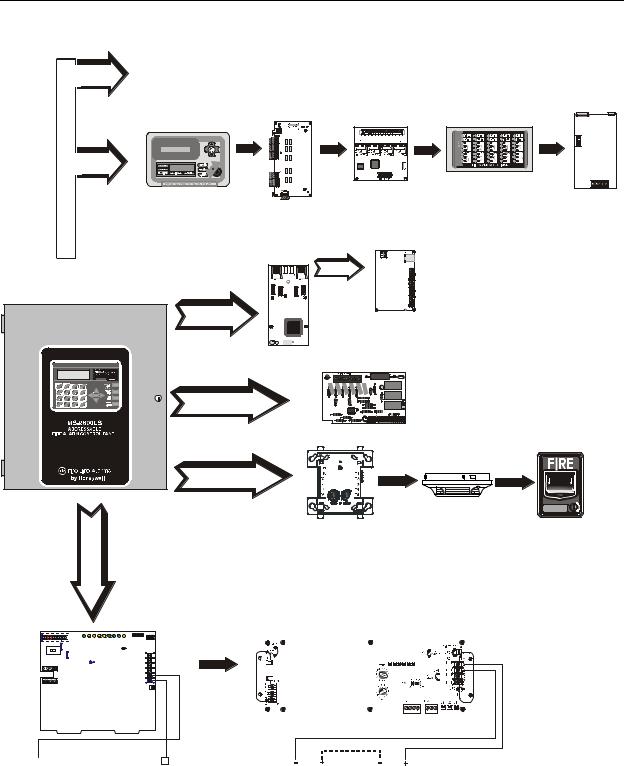
Peripheral Devices and Their Documents:
Audio Control for ACC-25/50(ZS/T) Audio-Command-Center Doc. #51889
|
|
ANN-I/O |
ANN-(R)LED |
|
|
ANN-80 |
|
LED Display |
ANN-S/PG |
||
|
LED Driver |
||||
Text Annunciator |
ANN-RLY |
Doc. #53032 |
|||
Doc. #151416 |
Printer Driver |
||||
Doc. #52749 |
Form-C Relay Card |
|
Doc. #151417 |
||
|
Doc. #53033 |
|
|
|
ANN (EIA-485) TB6 |
|
IPDACT |
|
Internet Communicator |
|
|
|
Doc. # 53109 |
|
|
DACT-UD2 |
|
J2 Connector |
Communicator |
|
Doc. # 53037 |
|
|
|
|
|
|
4XTMF |
|
|
Reverse Polarity |
|
|
module |
|
J10, J11 Connectors |
|
SLC Loop
Addressable Devices and SLC Wiring
Doc. # 51309
Battery Connector TB2
9600LSperi.wmf
|
|
|
|
|
|
|
|
|
|
|
|
|
|
|
|
|
|
|
|
|
|
|
|
|
|
|
|
|
|
|
|
|
|
|
|
|
|
|
|
|
|
|
|
|
|
|
|
|
|
|
|
|
|
|
|
|
|
|
|
|
|
|
|
|
|
|
|
|
|
|
|
|
|
|
|
|
|
|
|
|
|
|
|
|
|
|
|
|
|
|
|
|
|
|
|
|
|
|
|
|
|
|
|
|
|
|
|
|
|
|
|
|
|
|
|
|
|
|
|
|
|
|
|
|
|
|
|
|
|
|
|
|
|
|
|
|
|
|
|
|
|
|
|
|
|
|
|
|
|
|
|
|
|
|
|
|
|
|
|
|
|
|
|
|
|
|
|
|
|
|
|
|
|
|
|
|
|
|
|
|
|
|
|
|
|
|
|
|
|
|
|
|
|
|
|
|
|
|
|
|
|
|
|
|
|
|
|
|
|
|
|
|
|
|
|
|
|
|
|
|
|
|
|
|
|
|
|
|
|
|
|
|
|
|
|
|
|
|
|
|
|
|
|
|
|
|
|
|
|
|
|
|
|
|
|
|
|
|
|
|
|
|
|
|
|
|
|
|
|
|
|
|
|
|
|
|
|
|
|
|
|
|
|
|
|
|
|
|
|
|
|
|
|
|
|
|
|
|
|
|
|
|
|
|
|
|
|
|
|
|
|
|
|
|
|
|
|
|
|
|
|
|
|
|
|
|
|
|
|
|
|
|
|
|
|
|
|
|
|
|
|
|
|
|
|
|
|
|
|
|
|
|
|
|
|
|
|
|
|
|
|
|
|
|
|
|
|
|
|
|
|
|
|
|
|
|
|
|
|
|
|
|
|
|
|
|
|
|
|
|
|
|
|
|
|
|
|
|
|
|
|
|
|
|
|
|
|
|
|
|
|
|
|
|
|
|
|
|
|
|
|
|
|
|
|
|
|
|
|
|
|
|
|
|
|
|
|
|
|
|
|
|
|
|
|
|
|
|
|
|
|
|
|
|
|
|
|
|
|
|
|
|
|
|
|
|
|
|
|
|
|
|
|
|
|
|
|
|
|
|
|
|
|
|
|
|
|
|
|
|
|
|
|
|
|
|
|
|
|
|
|
|
|
|
|
|
|
|
|
|
|
|
|
|
|
|
|
|
|
|
|
|
|
|
|
|
|
|
|
|
|
|
|
|
|
|
|
|
|
|
|
|
|
|
|
|
|
|
|
|
|
|
|
|
|
|
|
|
|
|
|
|
|
|
|
|
|
|
|
|
|
|
|
|
|
CHG-75 Charger |
|
|
|
|
|
|
|
||||||||
|
|
|
CHG-120F Charger |
|
|
|
|
|
|
|
|
|
|
|
|
|
|
|||||||||||||||||||
|
|
|
|
|
|
|
|
|
|
|
Doc. # 51315 |
|
|
|
|
|
|
|
||||||||||||||||||
|
|
|
|
|
|
Doc. # 50888 |
|
|
|
|
|
|
|
|
|
|
|
|
|
|
|
|||||||||||||||
|
|
|
|
|
|
|
|
|
|
|
|
|
|
|
|
|
|
|
|
|
|
|
|
|
|
|
|
|
||||||||
MS-9600LS Series Manual — P/N 52646:B2 2/12/2010 |
11 |
Notes
12 |
MS-9600LS Series Manual — P/N 52646:B2 2/12/2010 |

Section 1: Product Description
The MS-9600LS and MS-9600UDLS are compact, cost effective, intelligent addressable FACPs (Fire Alarm Control Panels) with an extensive list of powerful features. The combination of Fire•Lite’s newer series devices and legacy 300 Series devices, along with the MS-9600LS or MS9600UDLS FACP, offer the latest in fire protection technology. The FLPS-7 power supply is a separate board while all other electronics are contained on a single main circuit board. Both boards are mounted to a chassis and housed in a metal cabinet, providing a complete fire control system for most applications. Optional modules, which plug into the main circuit board, are available for special functions. Available accessories include LED, graphic and LCD annunciators, reverse polarity/city box transmitter, digital alarm communicator/transmitter, SLC expansion module, local and remote upload/download software and remote power expansion.
The MS-9600UDLS includes a factory installed DACT-UD2 Digital Alarm Communicator Transmitter. Refer to “DACT-UD2 Installation” on page 52 and to the DACT-UD2 Manual Document #53037, which is supplied with the FACP, for DACT wiring and programming information. The DACT transmits system status (alarm, troubles, AC loss, etc.) to a Central Station via the public switched telephone network. It also allows remote programming or interrogation of the control panel using the PS-Tools Upload/Download utility via the public switched telephone network. Local programming and interrogation is also possible for the MS-9600UDLS using the PS-Tools and the USB port J4 on the DACT-UD2. The MS-9600LS can be programmed and interrogated locally using the serial port at TB7. Any personal computer with Windows® XP or greater and compatible modem with a speed of 2400 baud or faster and PS-Tools software may serve as a Service Terminal. This allows download of the entire program or upload of the entire program, history file, walktest data, current status and system voltages.
The MS-9600LSC is a ULC approved Canadian version of the FACP which offers the same features as the MS-9600LS, but is supplied standard with a DP-9692 dress panel. Refer to “Canadian Option” on page 113 for a full description.
The MS-9600LSE and MS-9600UDLSE offer the same features as the MS-9600LS and MS9600UDLS but allow connection to 220/240 VAC input.
NOTE: Unless otherwise specified, the terms FACP, MS-9600LS and MS-9600UDLS are used in this manual to refer to all versions of the FACPs.
1.1 Inventory
When the FACP shipment is received, check to make certain that all parts have been included in the shipment. The FACP shipment should consist of one of each of the following:
•main circuit board with display
•FLPS-7 Power Supply
•chassis (with main circuit board and power supply mounted)
•backbox with door and dress panel
•plastic bag containing screws, cables, key, etc.
•manual
1.2Features and Options
•New LiteSpeed™ polling protocol for faster SLC response time
•SLC operates up to 10,000 ft. (3,000 m) in LiteSpeed mode with twisted, unshielded wire or 3,000 ft (900 m) with untwisted, unshielded wire
•Single standard addressable SLC loop which meets NFPA Style 4, 6 and 7 requirements
MS-9600LS Series Manual — P/N 52646:B2 2/12/2010 |
13 |

Product Description |
Features and Options |
|
|
•Optional module for adding a second SLC loop which meets NFPA Style 4, 6 and 7 requirements
•318 addressable device capacity for each SLC loop (159 detectors and 159 control/monitor modules)
•99 software zones
•Up to four onboard NACs (Notification Appliance Circuits): four Style Y (Class B) or two Style Z (Class A)
•Additional NAC capability using control modules
•7.0 amps total power for NACs and 24 VDC auxiliary power outputs in alarm
•Two programmable relay outputs and one fixed trouble relay
•EIA-232 Printer/PC interface (variable baud rate)
•80-character LCD display (backlit)
•Real-time clock/calendar with daylight savings time control
•History file with 1,000 event capacity
•Advanced fire technology features:
•Automatic drift compensation
•Maintenance alert
•Detector sensitivity test capability (NFPA 72 compliant)
•Automatic device type-code verification
•Point trouble identification
•Waterflow selection per module point
•Alarm verification selection per detector point
•Walktest, silent or audible
•PAS (Positive Alarm Sequence) and Pre-signal per point (NFPA 72 compliant)
•New ANN-BUS Annunciators/Modules (ACS annunciators cannot be used when ANN-BUS annunciators/modules are connected)
•ANN-80 Remote Liquid Crystal Display point annunciator
•ANN-I/O LED Driver Module
•ANN-LED Alarm, Trouble, Supervisory Annunciator (minimum of one required for Canadian applications)
•ANN-RLED Alarm Annunciator
•ANN-S/PG Serial/Parallel Printer Module
•ANN-RLY Form-C Relay Module
•Automated activation of the ACC-25/50(ZS/T) Audio-Command-Center
•Legacy ACS/Term Annunciators: (ANN-BUS annunciator/modules cannot be used when ACS/Term annunciators are connected)
•ACM Series-LED Zone Annunciators
•LDM Graphic Annunciator Series
•LCD-80F Liquid Crystal Display point annunciator (LCD-80FC for Canadian applications)
•ACM-8RF Relay Module
•Silence inhibit timer option per NAC
•Autosilence timer option per NAC
•Continuous, March Time, Temporal or California code for main circuit board NACs with twostage capability
•Selectable strobe synchronization per NAC
•Remote Acknowledge, Alarm Silence, Reset and Drill via addressable modules, legacy ACS annunciators or ANN-80 Remote annunciator
14 |
MS-9600LS Series Manual — P/N 52646:B2 2/12/2010 |

Specifications |
Product Description |
|
|
•Auto-program (learn mode) reduces installation time. Reports two devices set to the same address
•Password and key-protected nonvolatile memory
•User programmable password
•Fully programmable from local keypad or keyboard or local PC
•Compatible with Fire•Lite’s newer series addressable devices (LiteSpeed and CLIP Mode) - Refer to SLC Wiring Manual for listing of all compatible addressable devices
•Compatible with legacy Fire•Lite’s 300 Series devices (CLIP Mode only) - Refer to SLC Wiring Manual for listing of all compatible addressable devices
•Optional 4XTMF module (conventional reverse polarity/city box transmitter)
•Optional DACT-UD2 Digital Alarm Communicator Transmitter, reports up to 99 zones or 636 points (all devices) to a UL listed Central Station. The DACT-UD2 is supplied standard with the MS-9600UDLS/E
•Optional PK-CD (contains PS-Tools utility) for local or remote Upload/Download of program and data.
•Optional DP-9692 dress panel (required for Canadian applications)
1.3Specifications
AC Power - TB1 of Power Supply Board
MS-9600LS(C) & MS-9600UDLS: 120 VAC, 50/60 Hz, 3.0 amps (L1=Hot, L2=Neutral) MS-9600LSE & MS-9600UDLSE: 240 VAC, 50 Hz, 1.5 amps (L1=Hot Leg 1, L2=Hot Leg 2) Wire size: minimum 14 AWG (2.00 mm2) with 600 V insulation
Battery (Sealed Lead Acid Only) - TB2
Maximum Charging Circuit: Normal Flat Charge - 27.6 VDC @ 1.00 amp Maximum Battery Size: 26 Amp Hour
Minimum Battery Size: 12 Amp Hour
(FACP cabinet holds maximum of two 18 Amp Hour batteries. For greater than 18 Amp Hour up to 26 Amp Hour batteries, use BB26 Battery Box)
For greater than 26 Amp Hour up to 75 Amp Hour batteries, use the CHG-75 Battery Charger and BB26 or BB-55F Battery Box. For greater than 75 Amp Hour up to 120 Amp Hour batteries, use the CHG-120F Battery Charger and BB-55F Battery Box.
Jumper JP3, on the FACP main circuit board, must be removed to disable the FACP battery charger when using the CHG-75 or CHG-120F.
Communication Loop - (Standard ) TB8 and (Optional SLC Expander Module) J3
24 VDC nominal, 27.6 VDC maximum
Maximum length - refer to “Wire Requirements” on page 196 Maximum loop current is 400 mA (short circuit) or 100 mA (normal) Maximum loop resistance is 40 ohms
Supervised and power-limited
Refer to SLC Wiring Manual for wiring information
NOTE: When installing SLC wiring in conduit, each loop must be installed in separate conduit.
Notification Appliance Circuits - TB4
Special Application power
Power-limited circuitry, supervised
NAC wiring requirements, refer to “NAC Wiring” on page 197
Nominal operating voltage: 24 VDC
Current-limit: fuseless, electronic, power-limited circuitry
MS-9600LS Series Manual — P/N 52646:B2 2/12/2010 |
15 |

Product Description |
Specifications |
|
|
Maximum signaling current per circuit: 3.00 amps (see Figure 1.1 on page 17) End-of-Line Resistor: 4.7 k , ½ watt (P/N 71252 UL listed) for NACs
Refer to Device Compatibility Document for listed compatible devices
Two Programmable and One Fixed Output Relay - TB1 & TB5
Contact rating: 2.0 amps @ 30 VDC (resistive), 0.5 amps @ 30 VAC (resistive) Form-C relays
Refer to Figure 2.5 on page 47 for information on power-limited wiring for relay circuits
Four-Wire Resettable Special Application Smoke Detector Power (24 VDC nominal) - TB3, Terminals 1 (+) & 2 (-)
Maximum ripple voltage: 10 mVRMS
Up to 1.5 amps is available for powering 4-wire smoke detectors (see Figure 1.1) Power-limited circuit, nonsupervised
Refer to Device Compatibility Document for listed compatible devices
Nonresettable Special Application Power #1 (24 VDC Nominal) - TB3, Terminals 3 (+) & 4 (-)
Maximum ripple voltage: 10mVRMS
Total DC current available from each output is up to 1.5 amps (see Figure 1.1) Power-limited circuit, nonsupervised
Nonresettable Special Application Power #2 (24 VDC Nominal) - TB3, Terminals 5 (+) & 6 (-)
Maximum ripple voltage: 10mVRMS
Total DC current available from each output is up to 1.5 amps (see Figure 1.1) Power-limited circuit, nonsupervised
EIA-485 (ACS/ANN-BUS) - TB6
ACS/ANN annunciator connector, Terminal 1 (+) and Terminal 2 (-)
EIA-485 (TERM) - TB7
Terminal Mode annunciator connector, Terminal 5 (In +), 6 (In -), 7 (Out +), 8 (Out -) Supervised, power-limited.
EIA-232 Serial - TB7
Local serial PC/Printer Connector, Terminal 1 (Transmit), 2 (Receive), 3 (DTR), 4 (Ground) Non-supervised, power-limited.
16 |
MS-9600LS Series Manual — P/N 52646:B2 2/12/2010 |
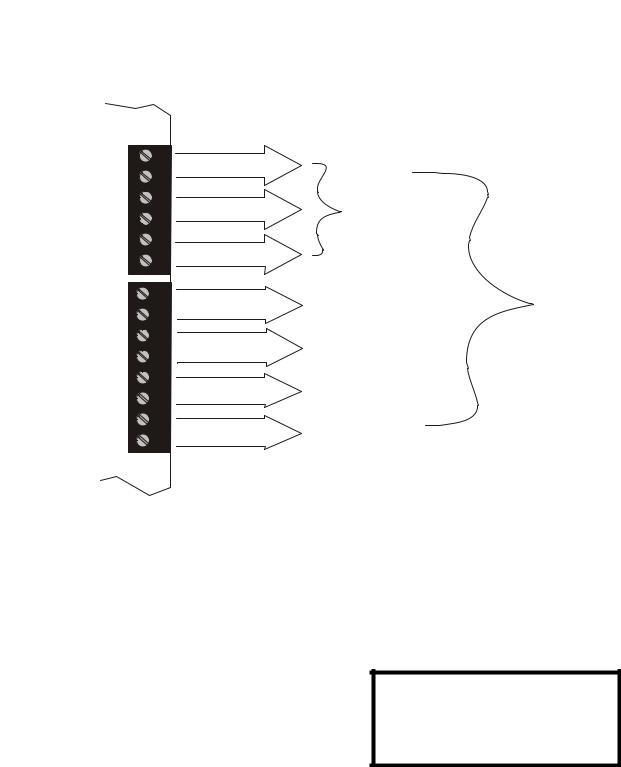
Controls and Indicators |
Product Description |
|
|
1.3.1 Current Availability
The following figure illustrates the maximum current that is possible for each panel circuit and the total current available from the FACP power supply.
TB3
Resettable Special |
1 |
|
Application Power |
|
|
for 4-wire smoke detectors |
2 |
|
Resettable Special |
3 |
|
Application Power |
4 |
|
Power #1 |
||
|
||
Resettable Special |
5 |
|
|
||
Application Power |
6 |
|
Power #2 |
|
|
NAC 1 |
1 |
|
Style Y or Z |
2 |
|
NAC 3 |
3 |
|
|
||
Style Y only |
4 |
|
|
||
NAC 2 |
5 |
|
|
||
Style Y or Z |
6 |
|
NAC 4 |
7 |
|
Style Y only |
8 |
TB4
1.5amps max per circuit
1.5amps max per circuit
1.5amps max per circuit
3 amps max per circuit
3 amps max per circuit
3 amps max per circuit
3 amps max per circuit
Standby
1.5 Amps Max*
per panel
Alarm
7 Amps Max
per panel
powerdist9600ls2.wmf
*The combined output current of all Special Applications Power circuits cannot exceed 1.5 amps in standby. Each circuit is capable of delivering the full 1.5 amps individually.
Refer to the battery calculations section for additional information.
Figure 1.1 Current Availability
1.4 Controls and Indicators
LCD Display
The FACP uses an 80-character (4 lines X 20 characters) high viewing angle LCD display. The display includes a long life LED backlight that remains illuminated. If AC power is lost and the system is not in alarm, the LED backlight will turn off to conserve batteries.
LED Indicators
HONEYWELL
LIFE SAFETY SYSTEM ALL NORMAL 10:00A 020102
LED indicators are provided to annunciate the following conditions:
•AC Power (green)
•Fire Alarm (red)
•Supervisory (yellow)
•Trouble (yellow)
MS-9600LS Series Manual — P/N 52646:B2 2/12/2010 |
17 |
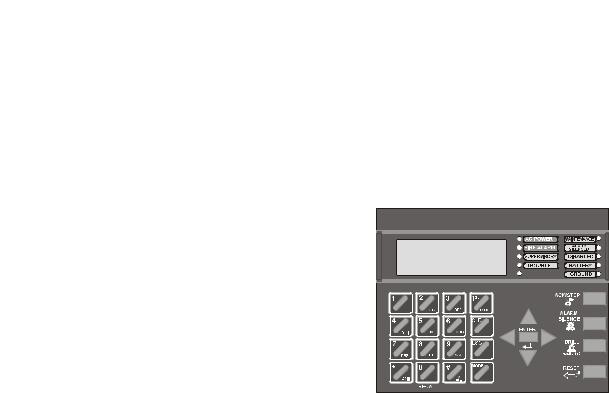
Product Description |
Circuits |
|
|
•Maintenance/presignal (yellow)
•Alarm Silenced signals (yellow)
•Disabled (yellow)
•Battery fault (yellow)
•Ground fault (yellow)
Key Panel
Mounted on the main circuit board, the key panel includes a window for the LCD display and LED indicators as listed above. The key panel, which is visible with the cabinet door closed, has 25 keys, including a 16 key alpha-numeric pad similar to a telephone keypad.
Function keys:
•Acknowledge/Step
•Alarm Silence
•Drill
•Reset (lamp test)
Service/program keys:
•Keys labeled 1 to 9
•* key
•# key
•0 (recall) key
•1st Event key
•Clear key
•Escape key
•Mode key
•Four cursor keys (up, down, left and right)
•Enter key
Local Piezo Sounder
9600kypd.wmf |
Figure 1.2 Membrane/Display Panel
A piezo sounder provides separate and distinct pulse rates for alarm, trouble and supervisory conditions.
1.5 Circuits
SLC Communication Loop
One SLC loop is provided standard on the FACP main circuit board. A second SLC loop is available by plugging the optional SLC module into connector J3 on the main circuit board. SLC loops, configurable for NFPA Style 4, 6 or 7, provide communication to addressable detectors, monitor (initiating device) and control (output device) modules. Refer to the SLC Wiring Manual for information on wiring devices.
Output Circuits
The following output circuits are available on the FACP:
•Special Application Power
•24 VDC Resettable (smoke detector power) output - 1.5 amps maximum
•24 VDC Nonresettable power output #1 - 1.5 amps maximum
•24 VDC Nonresettable power output #2 - 1.5 amps maximum
•24 VDC Battery Charger (up to 26 AH batteries)
18 |
MS-9600LS Series Manual — P/N 52646:B2 2/12/2010 |
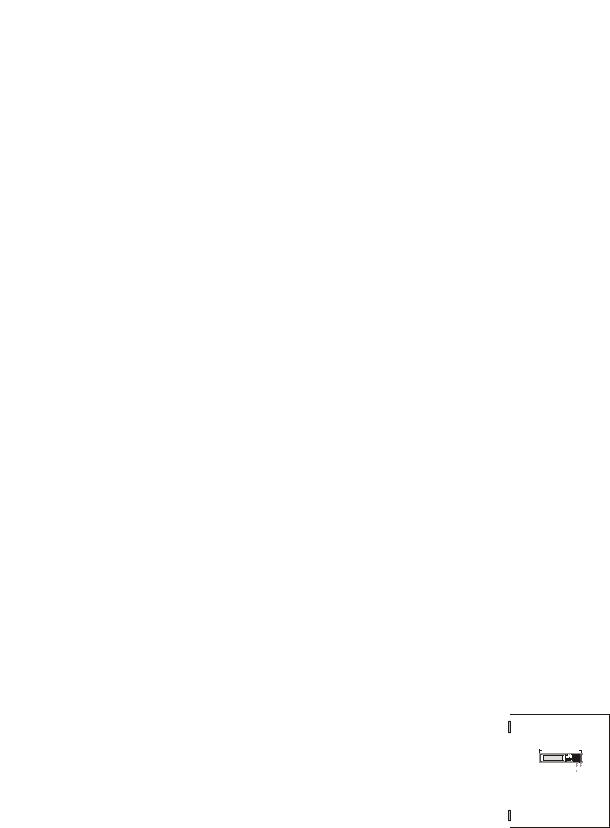
Components |
Product Description |
|
|
NAC (Notification Appliance Circuits)
Up to four NACs are provided with various programmable features:
•four Style Y (Class B) NACs
OR
• two Style Z (Class A) NACs
Relays
One fixed and two fully programmable Form-C dry contact relays are provided. The fixed fail-safe relay monitors system trouble and the two programmable relays are factory default programmed for system alarm and system supervisory. Contacts are rated 2.0 amps @ 30 VDC (resistive) and 0.5 amps @ 30 VAC (resistive). The programmable relays can be programmed for the following operations:
•fire alarm
•trouble
•supervisory
•supervisory auto-resettable
•DACT communication failure
•process monitor
•process monitor auto-resettable
•hazard alert
•medical alert
•AC loss
Auxiliary Trouble Inputs
Auxiliary Trouble Inputs can be connected to trouble bus outputs from auxiliary equipment, such as power supplies or normally-open dry contacts of a trouble relay to allow monitoring by the FACP.
1.6 Components
Main Circuit Board
The main circuit board contains the system’s CPU and other primary components and wiring interface connectors. Optional modules plug in and are mounted to the main circuit board. The circuit board is delivered mounted to a chassis which must be mounted to the backbox. Refer to the circuit board illustration on Page 10.
FLPS-7 Power Supply
The FLPS-7 Power Supply is provided as a separate module which is delivered mounted to a chassis which must be mounted to the backbox and connected to the main circuit board.
Cabinet
The FACP cabinet is red with a navy blue front overlay.
The backbox provides space for two batteries (up to 18 Amp Hour). Ample knockouts are provided for system wiring. Also available is an optional dress panel DP-9692, which mounts to the inside of the cabinet (required by ULC for Canadian applications).
Batteries


 ms-9600LS.wmf
ms-9600LS.wmf
Batteries must be sealed lead acid type. The FACP cabinet provides space for two batteries (up to 18 Amp Hour). Batteries larger than 18 Amp Hour up to 26 Amp Hour require use of the BB-26 or similar UL listed battery cabinet. The CHG-75 can be used for charging 26 to 75 AH batteries and
MS-9600LS Series Manual — P/N 52646:B2 2/12/2010 |
19 |

Product Description |
Components |
|
|
the BB-26 can be used for housing the batteries. The CHG-120F can be used for charging 26 to 120 AH batteries and the BB-55F can be used for housing the batteries. Batteries must be ordered separately.
1.6.1 Intelligent Addressable Detectors: Newer Series
Intelligent, addressable detectors provide information to the control panel on an SLC Signaling Line Circuit (refer to the SLC Wiring Manual for detailed information on device installation, wiring and operation). This allows the control panel to continually process the information to determine the status (alarm, trouble, maintenance or normal) of each detector. Each detector responds to an SLC address that is set in the detector head using built-in rotary decimal switches with the ability to select up to 159 addresses. Note that a blinking LED on an intelligent detector indicates communication between the detector and the control panel.
These devices (350 Series or newer) can operate in CLIP mode (Classic Loop Interface Protocol) or LiteSpeed mode to provide a quicker response. They are also compatible with older 300 Series devices. If a mix of old and new series devices are installed on the same loop, that loop must be programmed to operate in CLIP mode. Refer to the SLC Wiring Manual for a complete list of compatible addressable detectors.
1.6.2 Intelligent Addressable Modules: Newer Series
The newer series of Control Modules and Monitor Modules provide an interface between the control panel and conventional notification and initiating devices. Each module can be set to respond to an address with built-in rotary switches with the ability to select up to 159 addresses (a tab on the address switch must be broken off to use addresses 100-159). A blinking LED on a monitor module indicates communication between the module and the control panel.
These devices (350 Series or newer) can operate in CLIP mode (Classic Loop Interface Protocol) or LiteSpeed mode to provide a quicker response. They are also compatible with older 300 Series devices. If a mix of old and new series devices are installed on the same loop, the loop must be programmed to operate in CLIP mode. Refer to the SLC Wiring Manual for a complete list of compatible addressable modules. Refer to the Device Compatibility Document for a list of approved notification and initiating devices.
1.6.3 300 Series Intelligent Addressable Devices
Fire•Lite’s 300 Series Intelligent Addressable Devices are fully compatible with the MS-9600LS FACP. The FACP must be configured for CLIP Mode operation if the control panel is installed in an existing system with 300 Series devices. The address of 300 Series devices cannot be set above
99.Refer to the SLC Wiring Manual for a complete list of compatible addressable devices.
1.6.4Addressable Device Accessories
End-of-Line Resistor Assembly P/N R-47K
The 47 K End-of-Line Resistor assembly (P/N: R-47K) is used to supervise the MMF-300, MDF-300, MMF-301 and CMF-300 module circuits. The 3.9 K End-of-Line Resistor assembly is used to supervise the MMF-302 module circuit. The resistors are included with each module.
Power Supervision Relay
The UL listed End-of-Line power supervision relay (P/N: EOLR-1) is used to supervise the power to 4-wire smoke detectors and notification appliances.
20 |
MS-9600LS Series Manual — P/N 52646:B2 2/12/2010 |

Optional Modules |
Product Description |
|
|
N-ELR Mounting Plate
The N-ELR is a single End-of-Line resistor plate which is required for use in Canada. An ELR, which is supplied with each module and fire alarm control panel, is mounted to the ELR plate. Resistors mounted to the N-ELR plate can be used for the supervision of a monitor and control module circuit.
1.7 Optional Modules
The FACP main circuit board includes option module connectors for the following modules:
4XTMF Transmitter Module
The 4XTMF provides a supervised output for local energy municipal box transmitter, alarm and trouble reverse polarity. It includes a disable switch and disable trouble LED. A jumper on the module is used to select an option which allows the reverse polarity circuit to open with a system trouble condition if no alarm condition exists. The module plugs into connectors J10 and J11 which are located near the top left of the main circuit board. When the 4XTMF module is installed, Jumper JP6, on the main circuit board, must be cut to allow supervision of the module.
SLC-2LS Expander Module
The SLC-2LS Expander Module allows expansion of the FACP from one SLC circuit to two SLC circuits. The module plugs into connector J3 which is located in the lower right corner of the main circuit board. The wiring for the second SLC connects to terminals located on the expander module.
DACT-UD2 Digital Alarm Communicator/Transmitter
The DACT-UD2 is used to transmit system status to UL-listed Central Station receivers via the public switched telephone network. All circuitry and connectors are contained on a compact module which plugs into connector J2, which is located near the bottom center of the main circuit board.
The MS-9600UDLS/E is provided with a factory installed DACT-UD2. Refer to “DACT-UD2 Installation” on page 52 and to the DACT-UD2 manual, which is included with the FACP, for DACT-UD2 wiring and programming information.
IPDACT - Internet Protocol DACT
The IPDACT is a compact, Internet Protocol Digital Alarm Communicator/Transmitter designed to allow FACP status communication to a Central Station via the internet. No telephone lines are required when using the IPDACT. Using Contact ID protocol from the FACP, the IPDACT converts the standard DACT phone communication to a protocol that can be transmitted and received via the internet. It also checks connectivity between the FACP and Central Station. Refer to the IPDACT Product Installation Document P/N 53109 for additional information.
1.8Accessories
1.8.1PS-Tools Programming Utility
The PS-Tools Programming Utility can be used to locally or remotely program the FACP directly from most IBM compatible computers (PC), running Windows™ XP or newer. FACP program files can also be created and stored on the PC and then downloaded later to the control panel. The P/N: PK-CD Kit includes the FACP Windows-based Programming Utility software on CD-ROM with on-line help file. A standard USB cable with male-A to male-B connectors, which must be purchased separately, is required by the MS-9600UDLS for local connection of the PC to the USB port J4 on the DACT-UD2. The MS-9600LS requires connection to the Serial Port on FACP connector TB7. Remote programming requires that the PC have a 2400 baud or faster modem.
MS-9600LS Series Manual — P/N 52646:B2 2/12/2010 |
21 |

Product Description |
Accessories |
|
|
Important: Remote modification of FACP programming requires that the panel be enabled for remote download (refer to the DACT-UD2 manual). Remote interrogation of panel programming, history logs, detector status, etc., is possible without enabling the remote download option.
1.8.2 Dress Panel: DP-9692
A DP-9692 dress panel is available for the FACP (required for Canadian installations). The dress panel restricts access to the system wiring while allowing access to the key panel.
The MS-9600LSC has received ULC approval. ULC approval is contingent on the proper installation of the dress panel which is provided with the FACP
dp9600.wmf
1.8.3 TR-CE Trim Ring
An optional TR-CE trim ring is available for semi-flush mounting the FACP backbox.
1.8.4 Battery Box
BB-26
The BB-26 battery box may be used to house up to two 26 AH batteries and the CHG-75 Battery Charger. The battery box is red and is provided with knockouts.
BB-55F
The BB-55F battery box may be used to house two 26 AH batteries, two 60 AH batteries or one 100 AH battery. When the CHG-120 is mounted in the BB-55F, two 26 AH or one 60 AH battery may also be housed in the battery box.
1.8.5 Battery Charger
CHG-75 Battery Charger
The CHG-75 is capable of charging up to 75 AH lead-acid batteries with the MS-9600LS FACP. The FACP battery charger must be disabled when using the CHG-75. The charger and up to 26 AH batteries can be housed in the BB-26 battery box. Larger batteries and the charger can be housed in the BB-55F battery box which can be mounted up to 20 feet away from the control panel. Refer to the CHG-75 Manual for additional information.
CHG-120 Battery Charger
The CHG-120 is capable of charging up to 120 AH lead-acid batteries with the FACP. The FACP battery charger must be disabled when using the CHG-120. The batteries and charger can be housed in the BB-55F battery box which can be mounted up to 20 feet away from the control panel. Note that when using the BB-55F for housing the charger and batteries greater than 26AH, multiple BB-55Fs are required. Refer to the CHG-120 Manual for additional information.
22 |
MS-9600LS Series Manual — P/N 52646:B2 2/12/2010 |

Accessories |
Product Description |
|
|
1.8.6 New ANN-BUS Annunciators/Devices
NOTE: Refer to “Canadian Application” on page 200 for specific Canadian requirements.
WARNING: RISK OF ELECTRICAL SHOCK AND EQUIPMENT DAMAGE
DISCONNECT ALL SOURCES OF POWER (AC AND DC) BEFORE INSTALLING OR REMOVING ANY MODULES OR WIRING.
The legacy ACS annunciators may not be used if new ANN-BUS annunciators are being used due to incompatible serial communication protocols.
A variety of optional devices can be connected to the FACP EIA-485 ANN-BUS communication circuit. Compatible devices include:
•ANN-80 LCD Annunciator
•ANN-S/PG Serial/Parallel Printer Interface Module
•ANN-I/O LED Driver Module
•ANN-LED Annunciator Module (alarm, trouble, supervisory LEDs)
•ANN-RLED Annunciator Module (red alarm LEDs only)
•ANN-RLY Relay Module
ANN-BUS Wiring
This section contains information on calculating ANN-BUS wire distances and the types of wiring configurations (Class B).
Calculating Wiring Distance for ANN-BUS Modules
The following instructions will guide the installer in determining the type of wire and the maximum wiring distance that can be used with FACP ANN-BUS accessory modules.
To calculate the wire gauge that must be used to connect ANN-BUS modules to the FACP, it is necessary to calculate the total worst case current draw for all modules on a single 4-conductor bus. The total worst case current draw is calculated by adding the individual worst case currents for each module. The individual worst case values are shown in the following table:
Model Number |
Worst Case Current Draw1 |
ANN-80 LCD Annunciator |
0.040 amps |
|
|
ANN-S/PG Serial/Parallel Printer Interface Module |
0.040 amps |
|
|
ANN-I/O LED Driver Module |
0.200 amps |
|
|
ANN-(R)LED Annunciator Module |
0.068 amps |
|
|
ANN-RLY Relay Module |
0.075 amps |
|
|
1Total worst case current draw on a single ANN-BUS cannot exceed 0.5 amp. If current draw exceeds 0.5 amps, refer to “Powering ANN-BUS Devices from Auxiliary Power Supply” on page 26.
After calculating the total worst case current draw, Table 1.1 specifies the maximum distance the modules can be located from the FACP on a single wire run. The table ensures 6.0 volts of line drop maximum. In general, the wire length is limited by resistance, but for heavier wire gauges,
MS-9600LS Series Manual — P/N 52646:B2 2/12/2010 |
23 |

Product Description |
Accessories |
|
|
capacitance is the limiting factor. These cases are marked in the chart with an asterisk (*). Maximum length can never be more than 6,000 feet (1,800 m), regardless of gauge used. The formula used to generate this chart is shown in the note below.
Wiring Distance: ANN-BUS Modules to FACP
Total Worst Case Current |
22 Gauge |
18 Gauge |
16 Gauge |
14 Gauge |
|
Draw (amps) |
|||||
|
|
|
|
||
|
|
|
|
|
|
0.100 |
1,852 ft. |
4,688 ft. |
* 6,000 ft. |
*6,000 ft. |
|
|
|
|
|
|
|
0.200 |
926 ft. |
2,344 ft. |
3,731 ft. |
5,906 ft. |
|
|
|
|
|
|
|
0.300 |
617 ft. |
1,563 ft. |
2,488 ft. |
3,937 ft. |
|
|
|
|
|
|
|
0.400 |
463 ft. |
1,172 ft. |
1,866 ft. |
2,953 ft. |
|
|
|
|
|
|
|
0.500 |
370 ft. |
938 ft. |
1,493 ft. |
2,362 ft. |
|
|
|
|
|
|
Table 1.1 Wiring Distances
The following formulas were used to generate the wire distance chart:
Maximum Resistance (Ohms) |
= |
6.0 volts |
||
|
|
|||
Total Worst Case Current Draw (amps) |
||||
|
|
|||
Maximum Wire Length (feet) |
|
Maximum Resistance (Ohms) |
||
(6,000 feet maximum) |
= |
|
*500 |
|
|
||||
|
|
Rpu |
||
where: Rpu = Ohms per 1,000 feet for various Wire Gauges (see table below)
Wire Gauge |
Ohms per 1,000 feet (Rpu) |
|
|
22 |
16.2 |
|
|
18 |
6.4 |
|
|
16 |
4.02 |
|
|
14 |
2.54 |
|
|
Exception: When using the ANN-RLY module, the installer must ensure that the maximum 24VDC power line drop does not exceed 0.3 volts. This results in the following wiring limitations:
Wire Gauge |
Maximum Wire Length |
|
|
18 |
312 feet |
|
|
16 |
497 feet |
|
|
14 |
787 feet |
|
|
12 |
1,250 feet |
|
|
Wiring Distance Calculation Example:
Suppose a system is configured with the following ANN-BUS modules:
•3 ANN-80 Remote Fire Annunciators
•1 ANN-S/PG Serial/Parallel Printer Interface Module
•1 ANN-I/O LED Driver Module
24 |
MS-9600LS Series Manual — P/N 52646:B2 2/12/2010 |
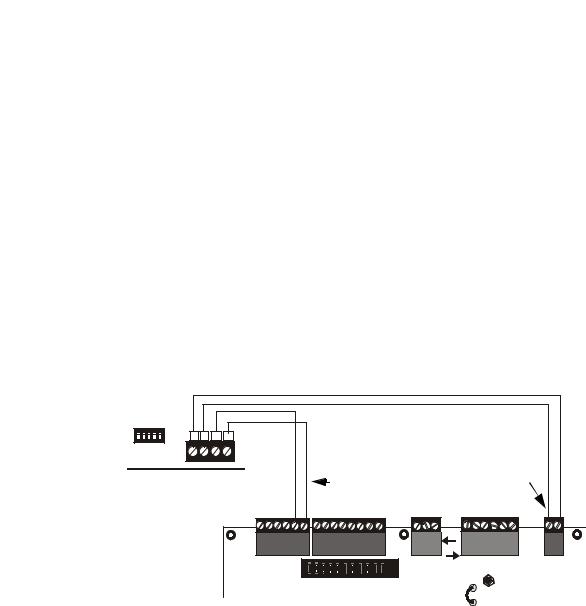
Accessories |
Product Description |
|
|
The total worst case current is calculated as follows:
ANN-80 Current Draw |
|
= 3 X 0.040 amps |
= 0.120 amps |
|
|
|
|
ANN-S/PG Current Draw |
|
= 1 X.0.040 amps |
= 0.040 amps |
|
|
|
|
ANN-I/O Current Draw |
|
= 1 X.0.200 amps |
= 0.200 amps |
|
|
|
|
Total Worst Case Current Draw |
|
= 0.360 amp |
|
|
|
|
|
Using this value and referring to the Wiring Distance Table 1.1 on page 24, it can be found that the available options are:
•463 feet maximum using 22 Gauge wire
•1,172 feet maximum using 18 Gauge wire
•1,866 feet maximum using 16 Gauge wire
•2,953 feet maximum using 14 Gauge wire
Wiring Configuration
Figure 1.3 illustrates the wiring between the FACP and ANN-BUS devices.
ANN-BUS and power wiring are supervised and power-limited
4 |
3 |
2 |
1 |
|
|
ANN-BUS/ |
ANN-BUS Device |
24 VDC |
|
||||
|
|
|
|
|
ACS BUS |
|
|
|
|
|
nonresettable |
|
|
|
|
|
|
|
|
|
|
|
|
TB3 + - + - + - |
|
TB1 |
A B |
|
|
|
TB4 |
TB5 |
TB6 + - |
|
|
|
|
|
JP8 |
|
|
|
|
|
|
FACP |
|
JP5 |
|
|
|
|
|
|
|
9600lstoann80.wmf
Figure 1.3 FACP wiring to ANN-BUS Device
MS-9600LS Series Manual — P/N 52646:B2 2/12/2010 |
25 |
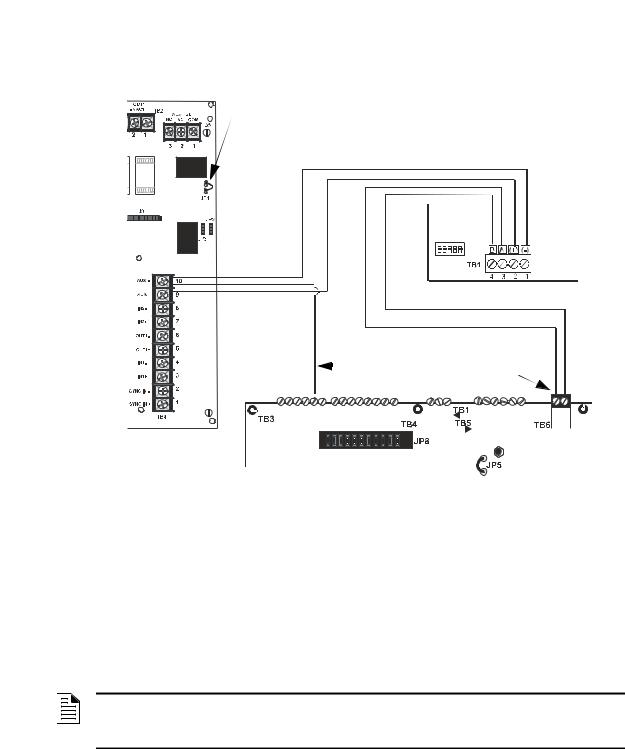
Product Description |
Accessories |
|
|
Powering ANN-BUS Devices from Auxiliary Power Supply
Figure 1.4 illustrates the powering of ANN-BUS devices from an auxiliary power supply such as the FCPS-24FS6/8, when the total ANN-BUS power requirement exceeds the capability of the FACP’s DC Power Output circuit.
Cut Ground Fault Detection jumper JP1 (FACP monitors for ground faults)
ANN-BUS and power wiring are supervised and power-limited
-24 VDC
|
|
|
|
|
|
|
|
|
|
|
|
|
|
|
|
|
|
|
|
|
|
|
|
|
|
|
|
|
|
|
|
|
|
|
|
|
|
|
|
|
|
|
|
|
|
|
|
|
|
|
|
|
|
|
|
|
|
|
|
|
|
|
|
|
|
|
|
|
ANN-80 |
|
|
||||||||
|
|
|
|
ANN-BUS |
|
|
|
|
|
|
|
|
|
|
|
||||
|
|
|
+24 VDC |
ANN-BUS/ |
|
|
|||||||||||||
|
|
|
|
|
|||||||||||||||
|
|
|
nonresettable |
ACS BUS |
|
|
|||||||||||||
|
|
|
|
|
|
|
|
|
|
|
|
|
|
|
|
|
|
|
|
|
|
|
|
|
|
|
|
|
|
|
|
|
|
|
|
|
|
|
|
|
|
|
|
|
|
|
|
|
|
|
|
|
|
|
|
|
|
|
|
|
|
|
|
|
|
|
|
|
|
|
|
|
|
|
|
|
|
|
|
9600lstofcpstoann.wmf
FCPS-24FS6/8
FACP
Figure 1.4 Powering ANN-BUS Devices from FCPS-24FS6/8
ANN-BUS Device Addressing
Each ANN-BUS device requires a unique address (ID Number) in order to communicate with the FACP. A 5-position DIP switch on each device is used to set this address. The address set for these devices must also be programmed at the FACP for the specific device (refer to the programming section titled “ANN-BUS Options” on page 121).
A maximum of 8 devices can be connected to the FACP ANN-BUS communication circuit. Device addresses do not need to be sequential and can be set to any number between 01 and 08. Note that 00 is not a valid address. The following table shows the DIP switch setting for each address.
NOTE: Address (ID Number) DIP switches on some devices may have more than 5 switch positions. Unless otherwise specified in the documentation supplied with each device, switch positions 6 and above must be set to OFF.
26 |
MS-9600LS Series Manual — P/N 52646:B2 2/12/2010 |

Accessories |
|
|
|
|
Product Description |
||
|
|
|
|
|
|
|
|
|
|
|
|
|
|
|
|
|
Address |
Switch 51 |
Switch 4 |
Switch 3 |
Switch 2 |
Switch 1 |
|
|
not valid |
OFF |
OFF |
OFF |
OFF |
OFF |
|
|
|
|
|
|
|
|
|
|
01 |
OFF |
OFF |
OFF |
OFF |
ON |
|
|
|
|
|
|
|
|
|
|
02 |
OFF |
OFF |
OFF |
ON |
OFF |
|
|
|
|
|
|
|
|
|
|
03 |
OFF |
OFF |
OFF |
ON |
ON |
|
|
|
|
|
|
|
|
|
|
04 |
OFF |
OFF |
ON |
OFF |
OFF |
|
|
|
|
|
|
|
|
|
|
05 |
OFF |
OFF |
ON |
OFF |
ON |
|
|
|
|
|
|
|
|
|
|
06 |
OFF |
OFF |
ON |
ON |
OFF |
|
|
|
|
|
|
|
|
|
|
07 |
OFF |
OFF |
ON |
ON |
ON |
|
|
|
|
|
|
|
|
|
|
08 |
OFF |
ON |
OFF |
OFF |
OFF |
|
|
|
|
|
|
|
|
|
1 Switch 5 must be set to OFF for ANN-BUS devices to be recognized.
ANN-80 Remote Fire Annunciator
The ANN-80(-W) Annunciator is a compact, 80 character, backlit LCD remote fire annunciator. It mimics the display on the control panel and will annunciate device type, point alarm, trouble or supervisory condition, zone assignment plus any custom alpha labels programmed into the FACP. The annunciator also provides system status LEDs to display AC Power, Alarm, Trouble, Supervisory and Alarm Silenced conditions. Additionally, the annunciator is capable of remotely performing critical system functions such as Acknowledge, Silence, Reset and Drill. Communication between the ANN-80 and FACP is accomplished over a two wire RS-485 serial interface employing the ANN-BUS communication format. The devices are powered, via two additional wires, from either the host FACP or remote UL-listed, filtered, power supply.
The function buttons, keyswitch and piezo sounder may be individually enabled and disabled through the FACP software. Refer to “ANN-BUS Options” on page 121 for a description of this feature and programming information.
Note that if the keyswitch is enabled and remains in the unlocked position for more than two minutes without any buttons being pressed on the annunciator, a trouble indication will be annunciated.
Specifications
•Operating Voltage Range: 18 VDC to 28 VDC
•Current Consumption @ 24 VDC nominal (filtered and nonresettable):
•Normal/Standby (no activity): 37.0 mA
•Trouble: 39.0 mA
•Alarm: 40.0 mA
•AC Fail ( not backlit): 15.0 mA
•For use indoors in a dry location
Installation
Ensure that all power (AC and DC) has been removed from the FACP before installing the annunciator.
Opening/Closing Annunciator
The following procedure details the steps used to open the annunciator in order to access the terminal block and DIP switches (refer to Figure 1.5 on page 28):
1.Turn the key switch to the ON (Unlocked) position by turning the key counter-clockwise.
2.Push in the snap latch located on the right side of the unit while pulling the cover open.
3.To close the cover, make certain the key switch is in the ON (Unlocked) position. Swing the cover closed, snapping it shut.
4.Turn the key switch to the OFF (Locked) position by turning clockwise and remove the key.
MS-9600LS Series Manual — P/N 52646:B2 2/12/2010 |
27 |
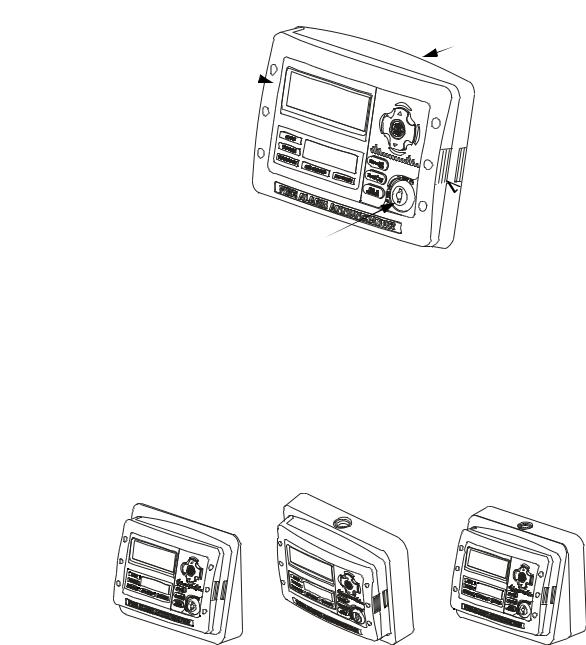
Product Description |
Accessories |
|
|
Annunciator cover with LCD display
Key switch shown in OFF/Locked position
 Annunciator backplate
Annunciator backplate
ann80_iso.wmf
 Press in latch and
Press in latch and

 Pull annunciator
Pull annunciator  cover open
cover open
Figure 1.5 ANN-80
Mounting
TheANN-80 can be surface or semi-flush mounted to a single, double or 4” square electrical box. Select and remove the appropriate knockout(s), pull the necessary wires through the knockouts and mount the annunciator in or on the wall depending on the type of installation desired.
The ANN-SB80KIT(-R/-B/-W) is an available mounting kit for the ANN-80 annunciator. The kit comes with a surface backbox and surface wedge for angled viewing. The two pieces can be used separately or can be stacked together.
The ANN-80 cover must be attached to the annunciator backplate before mounting the annunciator to the electrical box/wall. The cover cannot be reattached or removed after the annunciator has been mounted.
aann80kitmount.wmf
Annunciator mounted on |
Annunciator mounted on |
Annunciator mounted on stacked |
surface wedge from the |
surface backbox from the |
surface wedge and backbox from |
ANN-SB80KIT |
ANN-SB80KIT |
the ANN-SB80KIT |
28 |
MS-9600LS Series Manual — P/N 52646:B2 2/12/2010 |
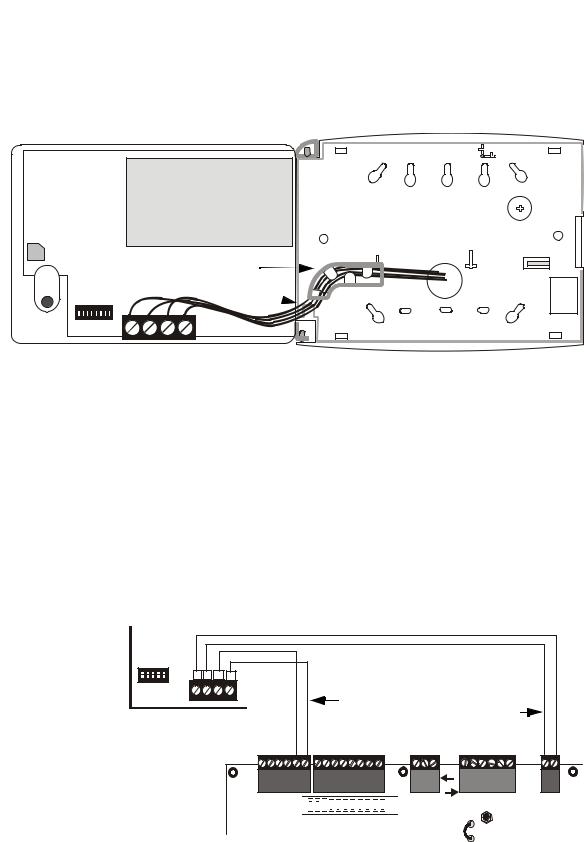
Accessories |
Product Description |
|
|
Wiring ANN-80 to FACP
The following steps can be used as a guide to wire the annunciator. Make certain all power has been removed from the FACP prior to annunciator installation.
1.Route wires from hole in backplate, through wiring channel and then to ANN-80 terminal block TB1.
TB1 |
80boxinside.wmf-ann |
|
wiring channel |
|
wires |
2.Remove appropriate amount of wire insulation.
3.Connect the wiring from the FACP ANN-BUS to annunciator TB1 terminals 3 (A) & 4 (B). Make certain to connect A to A and B to B.
4.If appropriate, connect the wiring going to the next device on the ANN-BUS to TB1 terminals
3& 4. Make certain to connect A to A and B to B.
5.Connect the wiring from the 24 VDC power source to annunciator TB1 terminals 1 (-) & 2 (+). Make certain to observe proper polarity.
6.If appropriate, connect the power wiring going to the next device to terminals
1(-) & 2 (+). Make certain to observe proper polarity.
7.After all connections are made, remove extra wire from inside of annunciator by dressing it neatly through wire channel, with any excess wire pushed back through hole into electrical box.
ANN-BUS and power wiring are supervised and power-limited
ANN-BUS
|
24 VDC |
ANN-BUS/ |
4 3 2 1 |
nonresettable |
|
ANN-80 |
|
ACS BUS |
TB3 + - + - + - |
|
TB1 |
A B |
TB4 |
TB5 |
TB6 + - |













































 JP8
JP8
JP5
FACP
Figure 1.6 ANN-80 Wiring to FACP
9600lstoann80.cdr
MS-9600LS Series Manual — P/N 52646:B2 2/12/2010 |
29 |
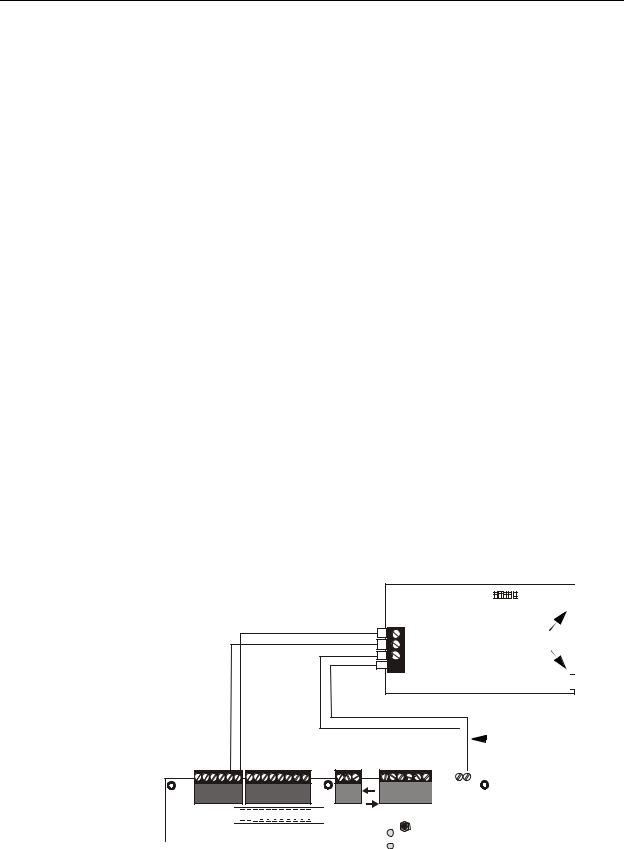
Product Description Accessories
The following table shows the ANN-80 connections to the FACP
FACP |
ANN-80 (TB1) |
|
|
Terminal GND (-) on TB3 |
Terminal 1 (-) |
|
|
Terminal PWR (+)TB3 |
Terminal 2 (+) |
|
|
Terminal ACS on TB6 |
Terminal 3 (A) |
|
|
Terminal ACS on TB6 |
Terminal 4 (B) |
|
|
Programming
Following installation and wiring of the ANN-80 LCD annunciator to the FACP, the annunciator must added to the system via FACP programming. Refer to the programming section titled “ANNBUS Options” on page 121 in this manual for detailed programming information. Select the LCD option for programming.
Trouble Response
If the ANN-80 is installed but the ANN-BUS is not enabled at the FACP, the ANN-80 will indicate a trouble condition by NOT turning on its AC Power indicator. The LCD will also display Key Bus Trouble and the piezo will sound approximately once every 10 seconds. Note that the FACP will provide no indication of an ANN-80 trouble.
To clear the ANN-80 trouble condition, enable the ANN-BUS and program the address corresponding to the address set on the ANN-80 at the FACP.
If the Keyswitch on the ANN-80 is left in the unlocked position for more than 2 minutes, a trouble condition will be indicated at the FACP.
ANN-S/PG Serial/Parallel Interface Installation
The ANN-S/PG Serial/Parallel Interface module allows the connection of a remote serial or parallel printer to the FACP for a real-time log of system events, detector status reports and event history. The module is provided with a plastic enclosure for surface mounting. Proceed with the installation as described in the following:
1.Ensure that all power (AC and DC) has been removed from the FACP.
2.Connect the ANN-S/PG to the FACP as illustrated in Figure 1.7.
ANN-BUS and power wiring are supervised and power-limited
(-)
(+)
A
B 


24 VDC  nonresettable
nonresettable
TB3 |
+ - + - + - |
TB1 |
|
TB4 |
TB5 |













































 JP8
JP8
 JP5
JP5
|
|
|
|
|
|
|
|
|
|
|
Parallel |
|
|
|
|
|
|
|
|
|
|
|
|
|
|
|
|
|
|
|
|
|
|
|
|
|
|
|
|
|
|
|
|
|
|
Cable Connectors for |
|
||||||||||||
|
connection to printer |
|
||||||||||||
|
|
|
|
|
|
|
|
|
|
|
Serial |
|
|
|
|
|
|
|
|
|
|
|
|
|
|
|
|
||
ANN-S/PG Module |
|
|||||||||||||
|
|
|
|
|
|
ANN-BUS/ |
|
|||||||
|
|
|
|
|||||||||||
|
|
|
|
|
|
ACS BUS |
|
|||||||
|
|
|
|
|
|
|
||||||||
|
|
|
|
|
|
|
|
|
|
|
|
|
|
|
|
|
|
|
|
|
|
|
|
|
|
|
|
|
|
|
|
|
|
|
|
|
|
|
|
|
|
|
|
|
|
|
+ - |
|
|
|
|
|
|
|
|
|
|
9600lstospg.wmf |
|
|
TB6 |
A B |
|
|
|
|
|
|
|
|
|
|
||
FACP
Figure 1.7 ANN-S/PG Connection to FACP
3.Using the DIP switches on the back of the ANN-S/PG module, assign an ID number (address) to the module.
30 |
MS-9600LS Series Manual — P/N 52646:B2 2/12/2010 |
